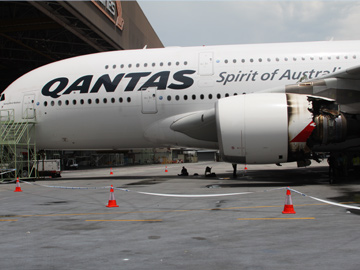
The ATSB today released the final report of its investigation into the uncontained engine failure involving a Qantas Airbus A380 over Batam Island, Indonesia on 4 November 2010.
The accident occurred shortly after the aircraft took off from Singapore. At about 7,000 ft above Batam Island, one of the aircraft’s Rolls-Royce Trent 900 engines failed, sending debris into the aircraft’s left wing and fuselage, and onto Batam Island. There was significant damage to the aircraft’s electrical, hydraulic and other systems. The crew managed the multitude of system failures before safely returning and landing the aircraft.
The ATSB found that the engine failure was the result of a fatigue crack in an oil feed pipe. The crack allowed the release of oil that resulted in an internal oil fire. The oil fire led to one of the engine’s turbine discs separating from the drive shaft. The disc then over-accelerated and broke apart, bursting through the engine casing and releasing other high energy debris.
The ATSB also found that the oil pipe, together with a number of similar pipes in other engines, had been made with a thin wall section and did not comply with the design specifications. The thin wall substantially increased the likelihood of fatigue cracking.
This investigation has been one of the more complex undertaken by the ATSB in recent years and has involved a large commitment of resources. As well as understanding how the engine failed, the investigation had to review why quality assurance did not adequately manage the oil pipe problem and what were the implications of the damage to the aircraft.
The ATSB worked closely with international regulators, Rolls-Royce and Airbus to ensure the continued safety of Trent 900-powered A380s. Early in the investigation, the ATSB issued a recommendation to Rolls-Royce about the manufacture of the oil feed stub pipes. As part of its final report, the ATSB issued recommendations to the European and US regulators so that lessons learned from this accident would be incorporated into aircraft certification advisory material designed to minimise hazards from uncontained engine failures.
As a result of the ATSB’s investigation, regulatory authorities and operators around the world took steps to ensure that engines with non-conforming oil feed stub pipes were identified and managed appropriately. Rolls-Royce also made changes to their quality assurance system to improve the way they manage non-conforming parts.
Read the report: In-flight uncontained engine failure Airbus A380-842, VH-OQA, overhead Batam Island, Indonesia, on 4 November 2010


